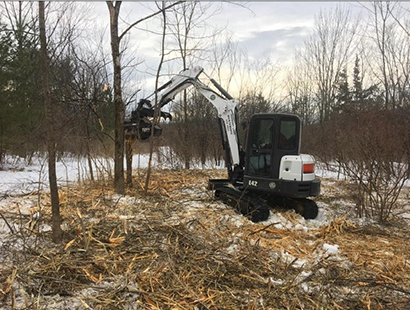Wheeler Nature Park – Habitat Management (Winter 2021/2022)
US Fish & Wildlife Service Habitat Management Project through Partners for Fish & Wildlife Program
In 2019, Audubon Vermont and the US Fish & Wildlife Service approached City staff about an opportunity to conduct habitat management work at the Wheeler Nature Park to support rare and unique bird species.
During an initial site visit, City staff (including members of the DPW Parks Crew) met with Margaret Fowle (Audubon VT) and Katie Kain (US Fish & Wildlife) to discuss management work that could be done at Wheeler. Following this meeting, Audubon provided the City with a habitat assessment and bird-friendly management recommendations for Wheeler. This work is part of their Champlain Valley Bird Initiative, which works with landowners to promote effective avian habitat management in the Champlain Valley. Their recommendations are based on habitat requirements of priority bird species that have been identified by the Vermont State Wildlife Action Plan and the North American Bird Conservation Initiative, and are the focus of regional conservation efforts. It should be acknowledged that while these recommendations are bird focused, there are numerous other non-avian species at the park that will also benefit from them.
In the management recommendations, Audubon identified early successional habitat types, mixed forests, and wetlands that are well suited to the following priority bird species: American Woodcock, Eastern Towhee, Blue- and Golden-winged Warbler, and Brown Thrasher. Audubon has identified invasive plant removal as being the primary habitat management consideration at Wheeler. Invasive species that are of concern at Wheeler, include: wild parsnip, reed canary grass, buckthorn, and honeysuckle. All of these plants provide suboptimal habitat for many bird species, and many create inhospitable habitats for them if not controlled. It is the management recommendation to focus on invasive plant removal at Wheeler, which would improve habitat availability for the priority birds.
 Invasive plant removal under this project will focus primarily on mechanical removal via a “Brontosaurus” mulching head/forestry mower, and a more targeted cut-stump method with direct herbicide application. The “Brontosaurus” is a smaller piece of equipment that allows for the operator to be more selective when using it in a natural area. It will also mulch the plant in place. This machine is only used in the winter months when the ground is frozen so as not to impact any sensitive ecosystems or habitats. The cut-stump method involves the cutting of invasive vegetation with a chainsaw, with direct follow-up with herbicide applied directly to the cut stump. This treatment is incredibly targeted and has less impact to the surrounding environment than a foliar herbicide application. It will also reduce the amount of follow-up required in future seasons. Herbicide will only be applied by certified applicators, likely from the US Fish & Wildlife Service, and this method has recently been implemented by both partners on a similar farm property in Charlotte.
Invasive plant removal under this project will focus primarily on mechanical removal via a “Brontosaurus” mulching head/forestry mower, and a more targeted cut-stump method with direct herbicide application. The “Brontosaurus” is a smaller piece of equipment that allows for the operator to be more selective when using it in a natural area. It will also mulch the plant in place. This machine is only used in the winter months when the ground is frozen so as not to impact any sensitive ecosystems or habitats. The cut-stump method involves the cutting of invasive vegetation with a chainsaw, with direct follow-up with herbicide applied directly to the cut stump. This treatment is incredibly targeted and has less impact to the surrounding environment than a foliar herbicide application. It will also reduce the amount of follow-up required in future seasons. Herbicide will only be applied by certified applicators, likely from the US Fish & Wildlife Service, and this method has recently been implemented by both partners on a similar farm property in Charlotte.
This project is eligible for funding through the US Fish & Wildlife Service Partners Program. Audubon Vermont is collaborating with the US Fish & Wildlife Service (USFWS) and the City on pursuing this funding for this management project. There is no formal application to access the funding, and the USFWS assesses projects on a case-by-case basis as funds become available. To utilize the funding, landowners are required to enter into a 10-year landowner agreement with the USFWS. This is a funding source that does not require a match by the partner, just a commitment to long-term management and monitoring.
The long-term monitoring can be mechanical (mowing) or chemical (herbicide), and a plan needs to be in place before starting the initial work. As the City has limited staff and resources, and much of this work has been identified in areas that are difficult to reach during the warmer months, herbicide application is being considered as a tool for long-term management. The concept of using herbicide to target invasive plant regrowth was presented to the City’s Natural Resources & Conservation Committee in February 2021. There was also a webinar on invasive plant management utilizing herbicides led by Ethan Tapper, the Chittenden County Forester, in March 2021. The take away from both of these events was that herbicide use should be considered one of the tools the City has to help manage the invasive plant population. It is not the first and only tool, but one of many. When the City prioritizes how to remove invasive plants from its natural areas, it will consider manual or mechanical removal first, utilizing volunteers from the Weed Warrior program, and having the parks crew mow areas when feasible. Herbicide application can be a useful tool, and is less time intensive as compared to manual methods.
This project is expected to kick off in February or March 2022, and will run until completion or the expiration of the agreement which ends December 2031.
